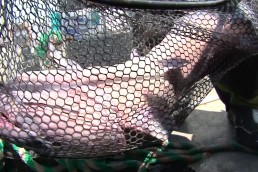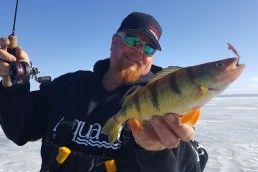What Will I Do this March? Hopefully, fish!
SHARE THIS POST
What will I do come March this year? I ask because, normally, I would be starting to teach my Beginners Fly-tying classes at Riveredge Nature Center. Most likely, that is not going to happen this year. There were many reasons for my “retirement,” but lack of interest, YouTube, and stores offering a class called the same as mine (but not as complete) for free—so the students would come into the stores and buy stuff—were the main ones. (It may still be done, but it will take some doing. See my website for details.)
I should be called to tie at the Milwaukee Journal Sentinel Sports Show early this month, but, as this is being written, that has not yet happened.
Of course, I will always be tying for myself, and there are always replacements to be made and new patterns to try. But I sure will miss showing others how to tie—although I do not tie with the many modern materials or methods. I tie, and teach, the old way. It works for me, but maybe not for everyone. Hmm!
Anyway, looking through my fly boxes, I see I need a few Green Butt Skunks. I will tie them on #4 and #6 salmon hooks. I will use Uni 6/0, black thread and tie them unweighted. I will use a few good straight and firm red hackle barbs for the tail, followed by a bright green, almost iridescent, chenille back (butt) half of the body. Then I will add some black chenille ribbed with silver tinsel for the front half. That will complete the body.
I will leave about three hook eyes of space between the chenille and the eye of the hook for the wing, the collar and the head. I will tie on a wing of white calf hair, just short of the overall length of the fly, including the tail. I’ll finish with a twist or three of black hackle wrapped around the hook (palmering), in front of the wing for the collar. Then I will end up making a neat-looking head using the thread to push back the hackle. Finishing that head with a whip finish knot and cement—in my case (and several other tiers), I will use nail polish.
This Green Butt Skunk is one of the favorite flies used to catch steelhead. It was first tied by a Mr. Dan Callahan supposedly sometime in the 1950s, but no one knows the date for sure.
Other flies I see that I must tie are Woolly Buggers. I use a lot of Woolly Buggers, and not only for steelhead. The Woolly is not a definite pattern, with a definite recipe, like the Green Butt Skunk. It is tied in many colors, and/or combination of colors, in many sizes. Some add rubber legs, Flashabou, and/or almost anything else that may look flashy or fishy.
Basically, it is tied with a marabou tail, a wrapped chenille body, with a hackle that starts with the small end of the hackle tied in at the tail. The hackle is then wrapped in the opposite direction of the chenille, toward the head, spaced like it was a rib. At the front of the fly, before you make the collar, this hackle should be longer than when it started.
Are you enjoying this post?
You can be among the first to get the latest info on where to go, what to use and how to use it!
Then, using the same hackle, you palmer two or three wraps to make the collar, tie off the hackle and form a nice head. Whip finish, then cement. This fly, if the right color is used that day, can save the trip for you. Fish seem to love it.
Continuing to look through my boxes, I noticed a half-buried, no-name streamer that I have had success with during past seasons. I was given a photo of the fly by a friend. I tied one and fished it, but never tied more. I wonder why?
Anyway, this fly is tied like this: a heavy #8 salmon hook with a turned up ey and black Uni 6/0 thread. The tail is orange marabou. The body is a highly reflective, clear, tinsel-like chenille palmered up the entire hook shaft to a gold conehead. Whip finish twice behind the cone, and that’s it! Simple, but effective.
I definitely will tie several of these.
So, I will tie some flies this month. What else will I do?
At Riveredge Nature Center I will also carry five-gallon buckets of sap, dumped from the bags or buckets hanging on the spiles drilled into maple trees, into a barrel. The trees will have been “tapped,” which means the trees are drilled and the spiles tapped into the holes with a hammer. This is usually done the last Saturday of February. Hopefully, after that, if the weather cooperates, several of us will be called, for the next six weeks or so, to help carry the buckets of sap, which will be boiled down into syrup and put into gallon jugs to be bottled and sold later. (Hopefully, there will be enough for the entire year.)
So, if it freezes at night and thaws, with some sunlight and low winds during the day, the sap should run a lot, and we will have to carry many buckets.
Between that activity and fly tying, and if at the end of the month the steelhead hopefully enter the tributaries of the Great Lakes to spawn, I won’t have to wonder what I am going to do during March. See you in the river.
MWO
SHARE THIS POST
Did you enjoy this post?
You can be among the first to get the latest info on where to go, what to use and how to use it!
Jerry Kiesow
Jerry Kiesow enjoys all aspects of the outdoors and shares them in many ways through his photos, words and workshops. He has written two books, Tales of The Peshtigo Putzer and Photos, Poems, and a Little Bit of Prose, that make great gifts. Check it all out at his website: jerrykiesowoc.com.


